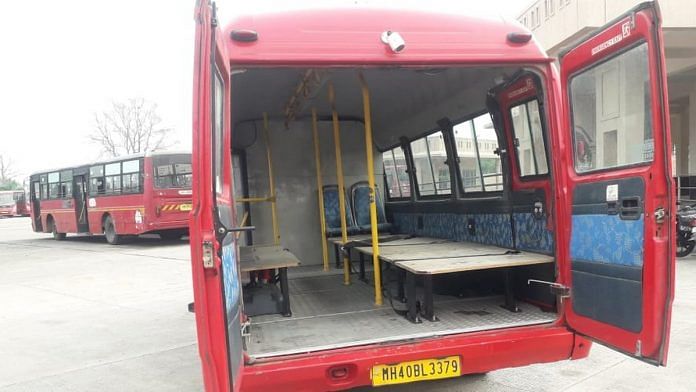Nagpur: The second wave of the Covid-19 pandemic currently sweeping across India has ratcheted up the daily death count in the cities and districts of Maharashtra, among whom Nagpur is the worst-affected after Mumbai, Pune and Nashik.
In the past week, the daily Covid bulletins have listed deaths between 10 and 40 a day, with a high of 60 on 1 April — the highest single-day deaths the district has seen in the second wave.
Anticipating a shortage of hearses, the Nagpur Municipal Corporation (NMC) has once again converted local public buses into ‘shav vahans’ and deployed them to ferry bodies, if necessary.
“Buses were converted into testing centres, and some were made into hearse vans. There are 12 mobile collection vans, and 3-4 hearse vans,” NMC Commissioner Radhakrishnan B. told ThePrint.
The commissioner clarified that though the city isn’t facing a shortage of hearses, the converted buses have been deployed “to pick up the load”.
Also read: Maharashtra’s worst-hit Amravati confirms disturbing trend — Covid is moving to rural areas
Plan was approved in September
According to NMC officials, the decision to convert three or four of the city’s ‘Aapli’ buses into hearses was first taken during a previous surge of cases in September last year, but they were turned back into buses. The administration, however, decided to convert some of them again last month.
“In the discussions, it came out that the number of deaths were too high in the Government Medical College and Hospital (GMC) and the Indira Gandhi Medical College & Hospital (IGMC),” said Sanjay Nipane, NMC additional municipal commissioner.
“It takes almost two hours to transport a body out of the hospital. There is some delay because of the relatives and doctors. The hearse vans were also getting delayed, so what we did is we converted these buses,” Nipane added.
The seats from the buses were removed and replaced with wooden boards on which stretchers with the corpses could be placed.
About 125 NMC workers are engaged in the process of ferrying the bodies to the crematoriums and the burial grounds. Each team, Nipane said, consists of five workers and one driver.
The Ambazari and Mokshadham crematoriums in the city have seen a rapid spike in the number of Covid bodies. Ambazari’s in-charge Ashok Khobragade said of the 20 bodies the crematorium receives daily, “75 per cent are people who died due to Covid”.
Vishwas Dipak Shahane, in-charge of the Mokshadham crematorium, added: “We are managing here. There is no shortage of vans; we have 10 hearse vans for 10 zones of the city. Three or four of the red buses are also functioning. We get anywhere between five to six bodies daily.”
Late hospitalisations, resource crunch
With the rise in the number of cases, hospitals in Nagpur have also had to shift gears.
Nagpur District Collector Ravindra Thakre added the administration is making an effort to increase the number of hospital beds. “We have four medical colleges, two of them run by the government, with a bed capacity of 1,300. Around 300 beds will be added within a week. We have around 350 beds in the other two private medical colleges, and we are going to increase the number of beds there too,” Thakre said.
The collector added that doctors are being brought in from Ayurvedic colleges, dental colleges and nursing colleges to address the shortage of staff.
Dr Avinash V. Gawande, medical superintendent at the GMC said: “We’re at full capacity. Patients from not just urban Nagpur and rural Nagpur but nearby districts including Chandrapur and Gadchiroli also come here… So there is a staff crunch.”
Gawande added: “We have a demand for about 60 to 70 doctors. So far, 15 to 17 doctors have joined (from other colleges); they will work in the Covid wards.”
According to Gawande, the increase in the number of deaths can be attributed to a delay in reporting cases. “In 20-30 per cent where a death has occurred, the patients were brought dead; in 20-25 per cent cases, the patient died within six hours of admission… About 19 per cent within three days of admission and 18-22 per cent died four days after admission,” he said.
“In the second wave, if the diagnosis and treatment happen in time, this many deaths will not happen. Recovery from Covid is possible,” Gawande stressed.
(Edited by Shreyas Sharma)
Also read: For Yavatmal farmers, Maharashtra Covid surge also brings back 2020 livelihood nightmare



